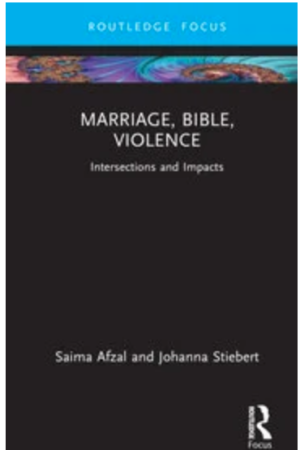Jessica M. Keady graduated from the University of Manchester and is Lecturer in Theology and Religious Studies at the University of Wales, Trinity Saint David. Jessica has worked extensively on ancient texts with special focus on sexuality and gender. Her monograph Vulnerability and Valour: A Gendered Analysis of Everyday Life in the Dead Sea Scrolls Communities has recently been published (Library of Second Temple Studies 91, Bloomsbury T&T Clark, 2017). While teaching at the University of Chester (before jetting off to Helsinki to take up a prestigious postgraduate research fellowship – and then promptly getting her current post!) Jessica was also actively involved in the Sexualities and Anglican Identities Project. You can follow Jessica on @JessicaMKeady.
————————————————-
Biblical rape texts like Genesis 34, the story of the rape of Dinah, can serve as a lens through which we can examine and critique ancient ideations of gender violence and purity. They also allow us to trace the ways these ideations continue to shape and inform contemporary understandings of rape. This can encourage readers and interpreters to perform an act of “political resistance” to biblical ideologies that sustain contemporary rape and purity cultures (particularly those pertaining to female sexuality and purity), and to assess the possible significance that such ideologies have for readers of the Bible today. As Sandie Gravett explains, recognizing rape in biblical texts “opens up the text beyond the bounds set thousands of years ago and invites translators to be more than passive recipients of ancient words and to do more than simply reinscribe the cultural norms of these past societies onto the modern stage” (2004: 298−9).
Defining Rape Culture and Purity Culture
Rape culture is a term used to describe the sociocultural normalization of sexual violence and its links to broader patterns of misogyny and sexism. Such normalization is woven through our global, civil, social, and cultural discourses: hence, rape-supportive hashtags trend on Twitter, rape “jokes” are a regular feature on TV shows and radio programmes, judges hand out lenient sentences to convicted rapists due to the perpetrators’ age, sporting or academic ability, or lack of criminal history, and rape complainants are commonly blamed for their own assaults because of their dress, alcohol intake, and sexual history. It is within this rape culture framework that religious texts, such as Genesis 34 are read, preached, and interpreted.
Moreover, rape cultures also give expression to various discourses around issues of purity, which again shape the contexts in which religious traditions are read. Purity (or modesty) culture is an intrinsic part of rape culture, which blames rape survivors, particularly female survivors, for their own violation. The dominant discourse of purity culture demands that women should remain sexually (and thus spiritually) “pure”, and that sexual activity outside of marriage renders a woman sexually and morally “defiled”—“used goods” with compromised economic and social value.
Additionally, purity culture discourses insist that it is the woman’s responsibility to “preserve” and “guard” her purity, by protecting her bodily boundaries from encroachments. Consequently, it is not uncommon for an applicant seeking political asylum to omit mention of experiences of sexual violence, especially if his or her religious tradition considers extra-marital sex a sin. Whether sex was entered into with consent or not, it is perceived as defiling. Therefore, to acknowledge rape is to acknowledge sinfulness and impurity, bringing shame upon rape survivors and, not infrequently, their families also (Einhorn and Berthold 2011: 41). Another way that rape culture and purity culture may exert impact on people’s experiences of sexual violence is in relation to survivors’ willingness to seek justice through the legal system. In the United Kingdom, an estimated nine out of ten rapes go unreported and only 6% of reported rapes end in a conviction. The reasons for under-reporting and low conviction rates are multiple and complex but the pernicious influences of rape culture play a part (Lees-Massey, Morris, and Tanner 2016).
This raises the question of how purity and rape cultures, particularly the issues of victim blaming and shaming, play a part here. Focusing particularly on female rape survivors, E. J. Graff argues that understanding rape as primarily a sexual violation places the burden on women to protect their bodies’ purity. Subsequently, public perceptions of sexual assault typically focus on the woman and her actions (was she drunk? What was she wearing? Did she flirt with her “attacker”? Was she “asking for it”?). Diversion is also evident in the case of Brock Turner, who, in his statement to Judge Aaron Persky placed the blame for his act of sexual assault on a student “party culture” of excessive drinking. That in turn allowed Turner’s defence lawyers to argue that the complainant was so intoxicated by alcohol that she could not know whether Turner had assaulted her without her consent (Fantz 2016; Grecian 2016). By implication, it was her failure adequately to guard her own sexual boundaries (and thus to preserve her “purity”) that rendered her culpable for her own violation. Gender violence, and the rape culture discourses that sustain it, are thus built upon unequal gendered power relations, which are themselves supported by patriarchy (Kilmartin 2007: 5). These relations create and sustain the rhetoric of rape cultures so ingrained within our world—a world where gender violence is normalized and survivors are routinely blamed for their own assaults, deterring them, frequently, from seeking support and justice.
Rape and Silence: The Portrayal of Dinah in Genesis 34
My reading of biblical rape narratives in the light of contemporary rape culture, intentionally juxtaposes ancient and contemporary understandings of sexual violence in order to better understand and respond to such violence. Although there are no biblical Hebrew words for “rape” or “rape culture”—as we understand these terms today—this does not mean that sexual violence is absent from the biblical text. On the contrary, many of the features contemporary commentators identify as central to rape culture—including discourses around female sexuality, male dominance, defilement, and purity—do appear in the Hebrew Bible.
In Genesis 34, Dinah, daughter of Leah and Jacob, is raped by Shechem. After the violent sexual encounter (v. 2), Shechem is so overcome with “love” for Dinah (v. 3) that he asks his father, Hamor the Hivite, to assist him in his plan to marry her (v. 4). When Jacob hears of his daughter’s defilement (tm’) he remains passive (v. 5), while his sons react strongly (they are “indignant and very angry”, v. 7). When Shechem and Hamor negotiate the marriage with Jacob (vv. 8-12), Dinah’s brothers demand that, before there can be any intermarriage between the Jacobite and Shechemite peoples, all Shechemite males must be circumcised (vv. 14-17). And, while the male Shechemites lie in pain after their mass circumcision, Dinah’s brothers attack the city and kill them all, including Shechem and Hamor. They then take back Dinah (who has presumably been kept captive by Shechem following her rape) and abduct the Shechemite women and children (vv. 25-9). When Jacob hears about these actions he condemns his sons (v. 30). In response, they ask if their sister should be treated “like a whore” and it is with this question that the narrative ends (v. 31). Dinah herself, meanwhile, remains silent throughout the entire narrative. We receive no insight into her perspective.
There has been, and continues to be, disagreement as to whether Dinah is raped in this biblical narrative, which is how I interpret and have summarized it above. Scholars have suggested a range of possibilities with regard to relations between Dinah and Shechem, from rape (e.g. Blyth 2010; Klopper 2010; Scholz 2000; Shemesh 2007), statutory rape (Frymer-Kensky 1998), and abduction marriage (Hankore 2013), to seduction (Bechtel 1994; Douglas 1993) and even romantic love (Fox 1983). Others conclude that the text is inconclusive (van Wolde 2002). I am persuaded that the text depicts Dinah’s rape. The strongest evidence in favour of this reading is, in my mind, the biblical Hebrew usage and ordering of the three verbs (lqḥ, škb, and ‘nh) used to describe Shechem’s actions towards Dinah (v. 2). These verbs unequivocally denote gendered violence in other biblical narratives, most significantly in the accounts of the rape of Tamar (2 Samuel 13:14) and the gang rape of the Levite’s concubine (Judges 19:25; cf. 20:5).
Dinah’s Defilement in Biblical Scholarship
In Genesis 34:5 we witness Jacob’s (lack of) reaction to his daughter’s sexual violation: “Now Jacob heard that Shechem had defiled (timmē’) his daughter Dinah; but his sons were with his cattle in the field, so Jacob held his peace until they came.” There are only three references to someone being “defiled” in Genesis and each appears in this chapter to describe the impact of Shechem’s sexual violation of Dinah (vv. 5, 13, 27). The Hebrew verb timmē’ is key to understanding the remainder of the narrative and, after its first appearance in v. 5, is used twice more by Dinah’s brothers with reference to vindication of her “defilement” (vv. 13, 27). On each of the three occasions it is used, timmē’ appears in the piel (that is, a Hebrew verb form that often expresses intensity), which translates as “to make impure, make unclean, defile, or desecrate” (Clines 2009: 141). Significantly, in Genesis 34, it is Dinah (and not Shechem) who is labelled as ritually unacceptable after her sexual assault.
For some scholars, however, Dinah’s defilement is less the result of her rape than a consequence of Shechem “taking” her virginity before she is properly given to him in marriage (e.g. Feinstein 2014: 67). Although Dinah’s sexual status is not discussed in Genesis 34, we might presume that she is unmarried, and, therefore, likely to be a virgin. This is also hinted at in the Septuagint translation of this narrative, which describes Dinah as a parthenos (a term that can be translated “virgin”). (For Graff, it is characteristic of rape cultures that women are expected to remain virgins until marriage, because women’s bodies are depicted primarily as vessels for procreation or male pleasure—and women must therefore strive to maintain their sexual purity.) Certainly, in the biblical traditions, a woman’s social “value” is typically measured according to her sexual chastity and purity; an unmarried non-virgin could not expect to garner her father a generous bride price, as her socio-sexual currency would be diminished.
Read within this framework of sexual violence and (dis)honour, Dinah’s rape is transformed from a violent assault on her personal integrity (as rape tends to be understood in modern western contexts) into a means of dishonouring and humiliating her male kin. This is due to the wider honour-shame context and because Shechem is understood to have exposed the Jacobite men’s incapacity to protect “their” women. Shechem’s misappropriation of Dinah’s sexuality (particularly his “theft” of her virginity) can thus be understood as an act that brings shame on her father Jacob, and on her brothers. The emphasis then, is on men and male honour, not on Dinah or the personal, devastating effect on her integrity or dignity.
Male violence continues to be in focus in Genesis 34:25-30. As they had planned, Simeon and Levi kill all the Shechemite males in the city and take the women and children as war spoil. After killing Hamor and Shechem with the sword, the brothers “took Dinah” (v. 26) out of Shechem’s house and went away. The use and echo of the verb lqḥ (“to take”) in verses 2 and 26 is significant, as the reader can trace the aggression inherent within the narrative from these two pivotal moments: Dinah is first “taken” (that is “raped”) by Shechem and later “taken back” by her brothers, as part of their violent revenge. Her silence in this narrative is absolute. What she herself thinks and feels about the events surrounding her “takings” is left unspoken. Had she been given the opportunity to address or to write a letter to Shechem, what would she have said? How would she have described the impact of rape and abduction? But like with so many survivors of sexual violence, Dinah’s voice—her narrative—is silenced. (NB: Some feminist artists have sought to redress this silencing. Hence, Anita Diamant has written a popular novel, which retells some of the stories of Genesis from Dinah’s first-person perspective. Notably, Diamant’s story as told in The Red Tent, does not depict Dinah’s relations with Shechem as violent.)
Conclusions
Recognizing rape in biblical narratives opens up the text and its literary figures and allows contemporary readers, teachers, and educators to question and query the social and gendered roles of these ancient societies in relation to our own. In a modern context, the narrative of Dinah in Genesis 34 touches on larger issues surrounding rape, female sexuality, purity, and the status of women. These issues need to be exposed, written about, taught, and understood within a framework that seeks actively to resist victim blaming and shaming, and to take into consideration the rape and purity cultures which pervade so many of our own cultural contexts. Reading Genesis 34 with this in mind demonstrates that biblical texts echo and perpetuate the damaging discourses prevalent within contemporary rape and purity cultures. This biblical narrative testifies to the silencing of a rape survivor, to the exoneration of violence, the dismissal of rape as “just sex”, and to the insistence that survivors are somehow “damaged” or “defiled” by rape.
As readers living in rape and purity cultures, we surely have a responsibility to contest these discourses, both in the biblical text and in our own cultural locations. If scholars, clergy, and educators simply refer to biblical rape narratives, such as Genesis 34, as love stories, filled with passion, romance and seduction, or accept unquestioningly the text’s own insistence that Dinah is “defiled” by her rape, then they risk perpetuating the harmful rhetoric that underpins many rape and purity cultures throughout the world today.
Works Cited
Bechtel, Lyn. 1994. “What if Dinah is Not Raped? (Genesis 34).” Journal for the Study of the Old Testament 19 (62): 19–36.
Blyth, Caroline. 2008. “Redeemed by His Love? The Characterization of Shechem in Genesis 34.” Journal for the Study of the Old Testament 33 (1): 3–18.
Blyth, Caroline. 2010. The Narrative of Rape in Genesis 34: Interpreting Dinah’s Silence. Oxford: Oxford University Press.
Clines, David. 2009. Concise Dictionary of Classical Biblical Hebrew. Sheffield: Sheffield Phoenix Press.
Douglas, Mary. 1993. In the Wilderness: The Doctrine of Defilement in the Book of Numbers. Sheffield: Sheffield Academic Press.
Einhorn, Bruce, and S. Megan Berthold. 2011. “Reconstructing Babel: Bridging Cultural Dissonance between Asylum Seekers and Adjudicators.” In Adjudicating Refugee and Asylum Status: The Role of Witness, Expertise, and Testimony, edited by Benjamin N. Lawrence and Galya Ruffer, 27–53. Cambridge: Cambridge University Press.
Feinstein, Eve Levavi. 2014. Sexual Pollution in the Hebrew Bible. Oxford: Oxford University Press.
Fox, Everett. In the Beginning: A New English Rendition of the Book of Genesis. New York: Schocken Books, 1983.
Frymer-Kensky, Tikva. 1998. “Virginity in the Bible.” In Gender and Laws in the Hebrew Bible and the Ancient Near East, edited by Victor Matthews, Tikva Frymer-Kensky, and Bernard M. Levinson, 86–91. Sheffield: Sheffield Academic Press.
Gravett, Sandie. 2004. “Reading “Rape” in the Hebrew Bible: A Consideration of Language.” Journal for the Study of the Old Testament 28: 279–99.
Hankore, Daniel. 2013. The Abduction of Dinah. Eugene, OR: Pickwick Publications.
Kilmartin, Christopher. 2007. Men’s Violence Against Women: Theory, Research and Activism. London: Routledge.
Klopper, Francis. 2010. “Rape and the Case of Dinah: Ethical Responsibilities for Reading Genesis 34.” Old Testament Essay 23 (3): 652–65.
Lees-Massey, Caitlin, Jessica Morris, and Dean Tanner. 2016. “A Complaint of Rape.” 24 Hours in Police Custody. Television Programme. London: Channel 4.
Scholz, Susanne. 2000. Rape Plots: A Feminist Cultural Study of Genesis 34. Studies in Biblical Literature 13. New York: Peter Lang.
Shemesh, Yael. 2007. “Rape is Rape is Rape: The Story of Dinah and Shechem.” Zeitschrift für die alttestamentliche Wissenschaft 119 (1): 2–21.
Wolde, Ellen van. (2002). ‘The Dinah Story: Rape or Worse?’ Old Testament Essays, 15/1: 225-39.
























